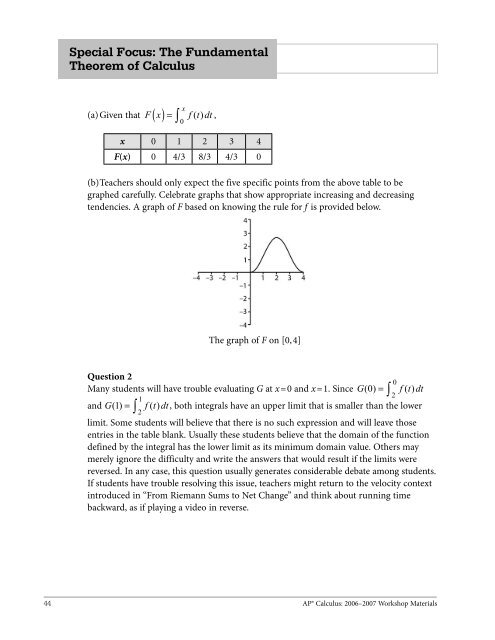AP Calculus
Calculus_SF_Theorem
Calculus_SF_Theorem
You also want an ePaper? Increase the reach of your titles
YUMPU automatically turns print PDFs into web optimized ePapers that Google loves.
Special Focus: The Fundamental<br />
Theorem of <strong>Calculus</strong><br />
(a) Given that F x<br />
x<br />
( ) = ∫ ( )<br />
0<br />
f t dt ,<br />
x 0 1 2 3 4<br />
F(x) 0 4/3 8/3 4/3 0<br />
(b) Teachers should only expect the five specific points from the above table to be<br />
graphed carefully. Celebrate graphs that show appropriate increasing and decreasing<br />
tendencies. A graph of F based on knowing the rule for f is provided below.<br />
The graph of F on [0,4]<br />
Question 2<br />
0<br />
Many students will have trouble evaluating G at x=0 and x=1. Since G( 0) = ∫ f ( t)<br />
dt<br />
2<br />
1<br />
and G( 1) = ∫ f ( t)<br />
dt, both integrals have an upper limit that is smaller than the lower<br />
2<br />
limit. Some students will believe that there is no such expression and will leave those<br />
entries in the table blank. Usually these students believe that the domain of the function<br />
defined by the integral has the lower limit as its minimum domain value. Others may<br />
merely ignore the difficulty and write the answers that would result if the limits were<br />
reversed. In any case, this question usually generates considerable debate among students.<br />
If students have trouble resolving this issue, teachers might return to the velocity context<br />
introduced in “From Riemann Sums to Net Change” and think about running time<br />
backward, as if playing a video in reverse.<br />
44<br />
<strong>AP</strong>® <strong>Calculus</strong>: 2006–2007 Workshop Materials


